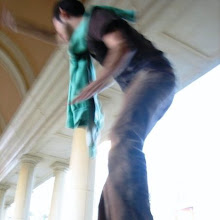 9. Lost In Translation (2003)
9. Lost In Translation (2003)There aren't many movies on this list that I can say resounded the way "Lost In translation" did the first time I saw it and still manage to maintain that original luster; even after six years and many, many viewings, Sofia Coppola's coming out party shines as bright as when I first saw it.
As slow developing and unstructured as the film seems, it's brilliance lies in the world Coppola constructs from various layers. From a purely technical standpoint, the soft focus and soft lighting that dominates the film casts the whole thing in a dreamlike haze, out of which everything else in the movie is strengthened, specifically the tone and pacing.
However, what's even more amazing is the reported "ad-lib" apparent throughout the entire making of the film--not just with some of Bill Murray's scenes. Not only was the film shot in just 27 days, but supposedly the script itself was more of a rough outline than anything else (Coppola used pictures she took around Japan to simulate the locations in the film) and she wasn't even sure if Murray was going to show up for shooting (she's said she wouldn't have made the film if she didn't get him for the role as it was written with him in mind). Sometimes though, things just work out, and a directors passion and dedication to a project are certainly a testament to this.
In the case of "Lost In Translations", things didn't just "work out". The film went out to get nominated for four Academy Awards (picture, actor, director and screenplay for which it won) and very high critical acclaim. Certainly Bill Murray put on (quite possibly) the performance of his career and one of the greatest of the decade, but the success and excellence of "Lost In Translation" extends far beyond the acting of Murray--and really even the script. Coppola took these pieces and painted an entire world around them, using the pallets available to her: images of Tokyo, bits and pieces from her own childhood and life experience and the dreamlike vision that really drove the film. The story itself is captured completely and complimented perfectly by the movie's slow (but not too much so), laissez-faire pacing and dream-like, "hazy" tone--in turn made possibly by the way the pacing itself and the style of shooting.
All of these elements came together unimaginably well by the hand of Coppola, creating a work that so richly captures the themes of the film--from loneliness and alienation in a completely foreign environment to deeper existential ideas of finding meaning in life through the viewpoint of different generations and human connection. These are certainly not light topics, but Sofia Coppola balances them with a deft hand and a light touch, letting them resonate subtly but with great impact. Murray and Scarlett Johansson complete the image, giving it vibrant life and meaning. If creating new worlds for an audience to step out of themselves and get lost in is one of the aims of filmmaking, then Coppola has succeeded with flying colors. Every time I watch "Lost In Translation", I lose myself in the Toyko she paints and in turn the characters that inhabit her framed, temporal world. And trust me, as a filmmaker, this is an incredibly difficult task and something I should strive to emulate with everything I make. I only hope Sofia Coppola can even get close to replicating the beautiful filmmaking she put on display in "Lost In Translation".

No comments:
Post a Comment